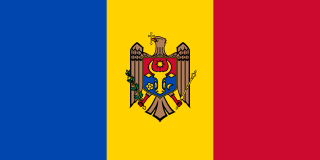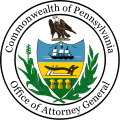
The Great Seal is the seal of the United States. The phrase is used both for the impression device itself, which is kept by the United States secretary of state, and more generally for the impression it produces. The obverse of the Great Seal depicts the national coat of arms of the United States while the reverse features a truncated pyramid topped by an Eye of Providence. The year of the U.S. Declaration of Independence, 1776, is noted in Roman numerals at the base of the pyramid. The seal contains three Latin phrases: E Pluribus Unum, Annuit cœptis, and Novus ordo seclorum.

The coat of arms of the Philippines features the eight-rayed sun of the Philippines with each ray representing the eight provinces which were placed under martial law by Governor-General Ramón Blanco Sr. during the Philippine Revolution, and the three five-pointed stars representing the three major island groups of Luzon, the Visayas, and Mindanao.

The national flag of the Republic of Moldova is a vertical triband of blue, yellow, and red, charged with the coat of arms of Moldova on the centre bar. The reverse is mirrored. The flag ratio is 1:2. Until further provisions, the State Flag of Moldova is used as the national flag and ensign as well; that is, civil, state and war flag and ensign.

The coat of arms of Australia, officially the Commonwealth Coat of Arms, is a formal symbol of the Commonwealth of Australia. It depicts a shield, containing symbols of Australia's six states, and is held up by native Australian animals, the kangaroo and the emu. The seven-pointed Commonwealth Star surmounting the crest also represents the states and territories, while golden wattle, the national floral emblem, appears below the shield.

The state flag of West Virginia was officially adopted by the West Virginia Legislature on March 7, 1929. The present flag consists of a pure white field bordered by a blue stripe with the coat of arms of West Virginia in the center, wreathed by Rhododendron maximum and topped by an unfurled red ribbon reading, "State of West Virginia." It is the only state flag to bear crossing rifles, meant to illustrate the importance of the state's fight for liberty during the Civil War as the southern unionist 35th state.

The Great Seal of the State of Georgia is a device that has historically been used to authenticate government documents executed by the state of Georgia. The first great seal of the state was specified in the State Constitution of 1777, and its current form was adopted in 1799 with alterations in 1914. Its specifications are currently spelled out by statute.

The Seal of the Commonwealth of Virginia is the official seal of the Commonwealth of Virginia, a U.S. state. The state flag of Virginia consists of the obverse of the seal against a blue background. A state flag was first adopted at the beginning of the American Civil War in April 1861, readopted in 1912, and standardized by the General Assembly in February 1950. The standing allegorical female figure of virtue is shown having vanquished tyranny, symbolized by a fallen king at her feet. She has an exposed breast in the manner of classical depictions of Amazons. The motto Sic semper tyrannis means "Thus always to tyrants."

The Great Seal of Scotland is a seal used by the first minister of Scotland to seal letters patent signed by the monarch giving royal assent to bills passed by the Scottish Parliament.

The Great Seal of Northern Ireland is the seal used for Northern Ireland. The great seal is in the possession of the Secretary of State for Northern Ireland. The Great Seal was created by the Irish Free State Act 1922 on the creation of Northern Ireland for possession by the Governor of Northern Ireland to "be used for all matters in Northern Ireland for which the Great Seal of Ireland was theretofore used".

The Great Seal of the State of Maryland is the official government emblem of the U.S. state of Maryland. Its official service is to authenticate acts by the General Assembly of Maryland, but it is also used for display purposes at most state buildings. Although the state seal has been changed in design several times throughout history, the current model represents the reverse side of the original seal.

The Seal of the State of Texas was adopted through the 1845 Texas Constitution, and was based on the seal of the Republic of Texas, which dates from January 25, 1839.

The Great Seal of the State of Ohio is the official insignia of the U.S. state of Ohio. All governmental offices, agencies, and courts in Ohio use variations of the state seal. Its primary feature is a circular coat of arms that depicts a sunrise in Chillicothe, Ohio's first capital, along with symbols of the state's origins. The seal sometimes appears with the state motto, "With God, All Things Are Possible".

The Great Seal of the State of West Virginia was adopted in September 1863. The obverse center of the seal contains a boulder that has been inscribed June 20, 1863, the date West Virginia became a state. In front of the boulder lie two crossed rifles and a liberty cap as a symbol of the state's fight for liberty. The two men on either side of the boulder represent agriculture and industry. On the left stands a farmer with an ax and plow before a cornstalk. On the other side stands a miner with a pickaxe, and behind him an anvil and sledge hammer. The outer ring contains the text "State of West Virginia" and the state's motto "Montani Semper Liberi",. The reverse of the seal, also called the lesser seal, is the official seal of the governor. Its motto reads "Libertas E Fidelitate".

The coat of arms of Iceland displays a silver-edged, red cross on blue shield, alluding to the design of the flag of Iceland. It is the only national arms to feature four supporters: the four protectors of Iceland (landvættir) as described in Heimskringla, standing on a block of columnar basalt. The bull (Griðungur) is the protector of northwestern Iceland, the eagle or griffin (Gammur) protects northeastern Iceland, the dragon (Dreki) protects the southeastern part, and the rock-giant (Bergrisi) is the protector of southwestern Iceland. Great respect was given to these creatures of Iceland, so much that there was a law during the time of the Vikings that no ship should bear grimacing symbols when approaching Iceland. This was so the protectors would not be provoked unnecessarily.

The coat of arms of Pennsylvania is an official emblem of the Commonwealth of Pennsylvania, alongside the seal and state flag, and was adopted in 1778.
The coats of arms of the U.S. states are coats of arms, that are an official symbol of the state, alongside their seal. Eighteen states have officially adopted coats of arms. The former independent Republic of Texas and Kingdom of Hawaii each had a separate national coat of arms, which are no longer used.

Texas is one of eighteen states that have adopted an official coat of arms. The current coat of arms is the same as the original coat of arms used by the Republic of Texas before its annexation into the United States.

Historical coats of arms of the U.S. states date back to the admission of the first states to the Union. Despite the widely accepted practice of determining early statehood from the date of ratification of the United States Constitution, many of the original colonies referred to themselves as states shortly after the Declaration of Independence was signed on 4 July 1776. Committees of political leaders and intellectuals were established by state legislatures to research and propose a seal and coat of arms. Many of these members were signers of the Articles of Confederation, Declaration of Independence, and United States Constitution. Several of the earliest adopted state coats of arms and seals were similar or identical to their colonial counterparts.
This article provides a list of notable depictions of the Great Seal of the United States, excluding the official dies.

The keystone symbol is the name commonly given to the de-facto state emblem of Pennsylvania. It is a stylized keystone, an architectural term for a wedge-shaped stone placed at the top of an arch. The shape consists of two isosceles trapezoids, each with the smaller side facing downward, with one being smaller, more flat, and placed on top of the other. The symbol alludes to Pennsylvania's official nickname, The Keystone State. Although the symbol has not been designated as the official state emblem, it is widely used by the Pennsylvanian government and by individuals.
































